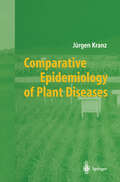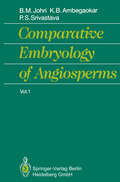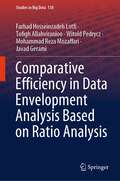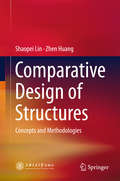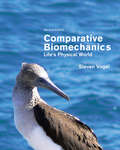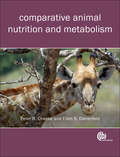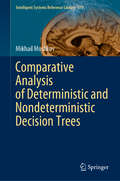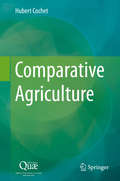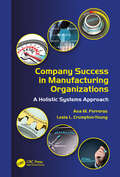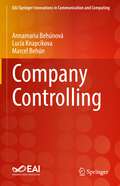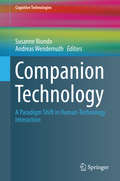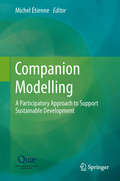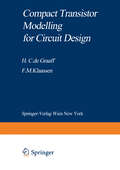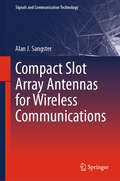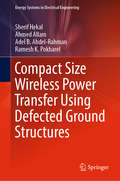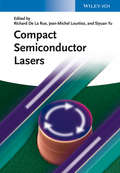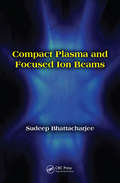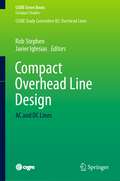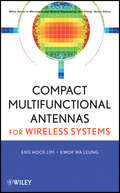- Table View
- List View
Comparative Epidemiology of Plant Diseases
by Jürgen KranzComparison is a powerful cognitive research tool in science since it does "across studies" to evaluate similarities and differences, e.g. across taxa or diseases. This book deals with comparative research on plant disease epidemics. Comparisons are done in specifically designed experiments or with posterior analyses. From the apparently unlimited diversity of epidemics of hundreds of diseases, comparative epidemiology may eventually extract a number of basic types. These findings are very important to crop protection. Plant disease epidemiology, being the ecological branch of plant pathology, may also be of value to ecologists, but also epidemiologists in the areas of animal or human diseases may find interesting results, applicable to their areas of research.
Comparative Embryology of Angiosperms Vol. 1/2
by Brij M. Johri Kunda B. Ambegaokar Prem S. SrivastavaCOMPARATIVE EMBRYOLOGY OF ANGIOSPERMS is a review of the developmental processes leading to sexual reproduction in flowering plants. On the basis of embryological data and certain evidences from other areas of study, it lays special emphasis on the relationship among and within the families and orders of angiosperms. Occasionally, inaccuracies in observation and interpretation are pointed out, alternative interpretations offered, gaps in our knowledge highlighted, and prospects outlined. The text is documented with 36 tables, 376 figures, and about 5000 literature citations, which contribute to making this book comprehensive. Besides students and research workers interested in angiosperm embyology, taxonomists, plant breeders, agriculturists, and horticulturists will also find much useful information in this treatise.
Comparative Efficiency in Data Envelopment Analysis Based on Ratio Analysis (Studies in Big Data #138)
by Farhad Hosseinzadeh Lotfi Tofigh Allahviranloo Witold Pedrycz Mohammad Reza Mozaffari Javad GeramiThe combination of DEA and ratio analysis is introduced as a suitable field for evaluating the performance of DMUs. In this regard, DEA-R is also proposed as a hybrid technique for calculating efficiency, ranking DMUs, and finding efficient faces. Therefore, the relationship between DEA and DEA-R provides a suitable field for researchers in the field of evaluating the performance of DMUs. The audience of this book is not limited to researchers in mathematics fields, but experts and students in industrial engineering and management fields also benefit from the topics of this book.
Comparative Design of Structures: Concepts and Methodologies
by Shaopei Lin Zhen HuangThis book presents comparative design as an approach to the conceptual design of structures. Primarily focusing on reasonable structural performance, sustainable development and architectural aesthetics, it features detailed studies of structural performance through the composition and de-composition of these elements for a variety of structures, such as high-rise buildings, long-span crossings and spatial structures. The latter part of the book addresses the theoretical basis and practical implementation of knowledge engineering in structural design, and a case-based fuzzy reasoning method is introduced to illustrate the concept and method of intelligent design. The book is intended for civil engineers, structural designers and architects, as well as senior undergraduate and graduate students in civil engineering and architecture. Lin Shaopei and Huang Zhen are both Professors at the Department of Civil Engineering, Shanghai Jiao Tong University, China.
Comparative Biomechanics: Life's Physical World, Second Edition (PDF)
by Steven VogelWhy do you switch from walking to running at a specific speed? Why do tall trees rarely blow over in high winds? And why does a spore ejected into air at seventy miles per hour travel only a fraction of an inch? Comparative Biomechanics is the first and only textbook that takes a comprehensive look at the mechanical aspects of life--covering animals and plants, structure and movement, and solids and fluids. An ideal entry point into the ways living creatures interact with their immediate physical world, this revised and updated edition examines how the forms and activities of animals and plants reflect the materials available to nature, considers rules for fluid flow and structural design, and explores how organisms contend with environmental forces. Drawing on physics and mechanical engineering, Steven Vogel looks at how animals swim and fly, modes of terrestrial locomotion, organism responses to winds and water currents, circulatory and suspension-feeding systems, and the relationship between size and mechanical design. He also investigates links between the properties of biological materials--such as spider silk, jellyfish jelly, and muscle--and their structural and functional roles. Early chapters and appendices introduce relevant physical variables for quantification, and problem sets are provided at the end of each chapter. Comparative Biomechanics is useful for physical scientists and engineers seeking a guide to state-of-the-art biomechanics. For a wider audience, the textbook establishes the basic biological context for applied areas--including ergonomics, orthopedics, mechanical prosthetics, kinesiology, sports medicine, and biomimetics--and provides materials for exhibit designers at science museums. Problem sets at the ends of chapters Appendices cover basic background information Updated and expanded documentation and materials Revised figures and text Increased coverage of friction, viscoelastic materials, surface tension, diverse modes of locomotion, and biomimetics
Comparative Animal Nutrition and Metabolism (PDF)
by Peter Cheeke Ellen DierenfeldNutrition is a very broad discipline, encompassing biochemistry, physiology, endocrinology, immunology, microbiology and pathology. Presenting the major principles of nutrition of both domestic and wild animals, this book takes a comparative approach, recognising that there are considerable differences in nutrient digestion, metabolism and requirements among various mammalian and avian species. Explaining species differences in food selection, food-seeking and digestive strategies and their significance to nutritional needs, chapters cover a broad range of topics including digestive physiology, metabolic disorders and specific nutrients such as carbohydrates proteins and lipids, with particular attention being paid to nutritional and metabolic idiosyncrasies. It is an essential text for students of animal and veterinary sciences.
Comparative Animal Nutrition and Metabolism
by Peter Cheeke Ellen DierenfeldNutrition is a very broad discipline, encompassing biochemistry, physiology, endocrinology, immunology, microbiology and pathology. Presenting the major principles of nutrition of both domestic and wild animals, this book takes a comparative approach, recognising that there are considerable differences in nutrient digestion, metabolism and requirements among various mammalian and avian species. Explaining species differences in food selection, food-seeking and digestive strategies and their significance to nutritional needs, chapters cover a broad range of topics including digestive physiology, metabolic disorders and specific nutrients such as carbohydrates proteins and lipids, with particular attention being paid to nutritional and metabolic idiosyncrasies. It is an essential text for students of animal and veterinary sciences.
Comparative Analysis of ICT in Education Between China and Central and Eastern European Countries (Lecture Notes in Educational Technology)
by Dejian Liu Ronghuai Huang Bojan Lalic Haijun Zeng Nikola ZivlakThis book presents the status quo of Information and Communication Technology (ICT) in Education, with a focus on China and the 17 Central and Eastern European Countries (CEECs), including Albania, Bosnia and Herzegovina, Bulgaria, Croatia, the Czech Republic, Estonia, Greece, Hungary, Latvia, Lithuania, Macedonia, Montenegro, Poland, Romania, Serbia, Slovakia and Slovenia (the “17+1” cooperation mechanism, as an incubator for pragmatic trans-regions cooperation platform, created by China and the 17 CEECs). With recent advances in ICT in China and the CEECs, it has assumed increasingly important roles in education, including the improvement of the quality of teaching and learning, as well as the promotion of equity in education. The significant contribution of ICT in education is an enabler to achieving the goals of the “17+1 cooperation” mechanism between China and the CEECs, which has attracted considerable attention worldwide, given fresh impetus to cooperation between the two parties, and opened a new chapter in China-CEEC cooperation.The contributors, all of whom hail from these 18 countries, describe the state-of-the-art of ICT in education in their respective country, and focus on three major aspects, namely: the country profile, general status of education development, and ICT in education. In turn, leading experts in educational informatization research compare the situations in different countries. Taken together, the papers offer valuable insights for policymakers and educators on how to integrate ICT into educational processes, and on inter-regional cooperation with regard to ICT in education.
Comparative Analysis of Deterministic and Nondeterministic Decision Trees (Intelligent Systems Reference Library #179)
by Mikhail MoshkovThis book compares four parameters of problems in arbitrary information systems: complexity of problem representation and complexity of deterministic, nondeterministic, and strongly nondeterministic decision trees for problem solving. Deterministic decision trees are widely used as classifiers, as a means of knowledge representation, and as algorithms. Nondeterministic (strongly nondeterministic) decision trees can be interpreted as systems of true decision rules that cover all objects (objects from one decision class). This book develops tools for the study of decision trees, including bounds on complexity and algorithms for construction of decision trees for decision tables with many-valued decisions. It considers two approaches to the investigation of decision trees for problems in information systems: local, when decision trees can use only attributes from the problem representation; and global, when decision trees can use arbitrary attributes from the information system. For both approaches, it describes all possible types of relationships among the four parameters considered and discusses the algorithmic problems related to decision tree optimization. The results presented are useful for researchers who apply decision trees and rules to algorithm design and to data analysis, especially those working in rough set theory, test theory and logical analysis of data. This book can also be used as the basis for graduate courses.
Comparative Agriculture
by Hubert CochetIn the first section dedicated to theoretical thoughts on comparative agriculture, Hubert Cochet introduces the notion of “agricultural development”, the very subject of comparative agriculture, with a restored endogenous dimension. He then describes how this approach was slowly consolidated, around the concept of agrarian system in particular. The comparison of agricultural transformations in time and space highlights the importance of the comparatist approach to production processes, their trajectories and differentiation on a worldwide scale. The second section which focuses on the methods and expertise of comparative agriculture, tackles the issues of landscape analysis, field surveys and the historical approach underlying comparative agriculture. It sums up the economic tools mobilised as well as the evaluation perspectives opened up by comparative agriculture.
Company Success in Manufacturing Organizations: A Holistic Systems Approach (Systems Innovation Book Series)
by Ana M. Ferreras Lesia L. Crumpton-YoungIn the past, company success was typically measured by financial indicators. Lately though, non-financial measures such as employee morale have become popular. Although there are approaches that look into quantitative and qualitative performance measures affecting company success, none of them characterize it in a holistic way, combining all the critical performance measures. This book presents a multifaceted approach that prepares engineers and future organizational leaders/managers to measure, monitor, and predict company success in a more meaningful way.
Company Success in Manufacturing Organizations: A Holistic Systems Approach (Systems Innovation Book Series)
by Ana M. Ferreras Lesia L. Crumpton-YoungIn the past, company success was typically measured by financial indicators. Lately though, non-financial measures such as employee morale have become popular. Although there are approaches that look into quantitative and qualitative performance measures affecting company success, none of them characterize it in a holistic way, combining all the critical performance measures. This book presents a multifaceted approach that prepares engineers and future organizational leaders/managers to measure, monitor, and predict company success in a more meaningful way.
Company Man
by Joseph FinderWould you cover up murder to protect your family? Nick Conover, CEO of a major corporation, is a widower and single dad, struggling to bring up his ten-year-old daughter and angry sixteen-year-old son alone. Then his family is threatened by a nameless stalker, and Nick is faced with a dead body and damning circumstances. To protect his family, he must cover up this murder. Now Audrey Rhimes, a police investigator with a mission of her own, is determined to connect Nick to the murder. But Nick has begun to unravel a web of intrigue within his own corporation. His revelations could gut the company and bring him down with it. With everything he spent his life working for hanging in the balance, Nick Conover discovers that life at the top is just one small step away from a long plunge to the bottom... Recent reviews for Joseph Finder: 'Stunning... I can't remember when I last read a book so gripping and so satisfying' PETER JAMES. 'Smart, swift and well-informed' SCOTT TUROW. 'Terrific' IAN RANKIN. 'A writer at the top of his game' MARK BILLINGHAM. 'Fantastic... Kept me absolutely on the edge of my seat' MARTINA COLE. 'Timely, twisty and impossible to put down' KARIN SLAUGHTER. 'A masterclass in ratcheting up the tension... A classy, sophisticated thriller' J.P. DELANEY.
Company Controlling (EAI/Springer Innovations in Communication and Computing)
by Lucia Knapcikova Annamaria Behúnová Marcel BehúnThe book discusses the study and implementation of controlling in the modern enterprise from the perspective of Industry 4.0, which helps ensure the efficient and effective use of organizational resources in order to achieve planned goals. The aim of this book is to provide the most comprehensive and effective exchange of information on current developments in Enterprise Controlling. The authors describe lean/agile approaches that enterprises can use to reach the highest level of competitiveness in a global environment and help establish channels of communication and disseminate knowledge among professionals working in manufacturing and related institutions. The authors aim to help facilitate corporate coordination and help with its planning without deviating from standards. The publication is dedicated to all who want to learn in the field of controlling from researchers and academics to students.
Companion Technology: A Paradigm Shift in Human-Technology Interaction (Cognitive Technologies)
by Susanne Biundo Andreas WendemuthFuture technical systems will be companion systems, competent assistants that provide their functionality in a completely individualized way, adapting to a user’s capabilities, preferences, requirements, and current needs, and taking into account both the emotional state and the situation of the individual user.This book presents the enabling technology for such systems. It introduces a variety of methods and techniques to implement an individualized, adaptive, flexible, and robust behavior for technical systems by means of cognitive processes, including perception, cognition, interaction, planning, and reasoning. The technological developments are complemented by empirical studies from psychological and neurobiological perspectives.
Companion Modelling: A Participatory Approach to Support Sustainable Development
by Michel ÉtienneThis book introduces the companion modelling approach by presenting the stance that underpins it, the methods and tools used with stakeholders and the specific role of models during the process. It addresses the means to deal with the different levels of decision-making and to take into account the various power relationships. It proposes a methodology to assess the impact of the approach on the stakeholders involved in the process.The book includes 27 case studies and 7 teaching tools that describe the successful use of the approach in a variety of settings or teaching contexts. It is intended for researchers working on rural development or renewable resources management, as well as students and teachers.
Compact Transistor Modelling for Circuit Design (Computational Microelectronics)
by Henk C. Graaff Francois M. KlaassenDuring the first decade following the invention of the transistor, progress in semiconductor device technology advanced rapidly due to an effective synergy of technological discoveries and physical understanding. Through physical reasoning, a feeling for the right assumption and the correct interpretation of experimental findings, a small group of pioneers conceived the major analytic design equations, which are currently to be found in numerous textbooks. Naturally with the growth of specific applications, the description of some characteristic properties became more complicated. For instance, in inte grated circuits this was due in part to the use of a wider bias range, the addition of inherent parasitic elements and the occurrence of multi dimensional effects in smaller devices. Since powerful computing aids became available at the same time, complicated situations in complex configurations could be analyzed by useful numerical techniques. Despite the resulting progress in device optimization, the above approach fails to provide a required compact set of device design and process control rules and a compact circuit model for the analysis of large-scale electronic designs. This book therefore takes up the original thread to some extent. Taking into account new physical effects and introducing useful but correct simplifying assumptions, the previous concepts of analytic device models have been extended to describe the characteristics of modern integrated circuit devices. This has been made possible by making extensive use of exact numerical results to gain insight into complicated situations of transistor operation.
Compact Slot Array Antennas for Wireless Communications (Signals and Communication Technology)
by Alan J. SangsterThis book describes and provides design guidelines for antennas that achieve compactness by using the slot radiator as the fundamental building block within a periodic array, rather than a phased array. It provides the basic electromagnetic tools required to design and analyse these novel antennas, with sample calculations where relevant. The book presents a focused introduction and valuable insights into the relevant antenna technology, together with an overview of the main directions in the evolving technology of compact planar arrays. While the book discusses the historical evolution of compact array antennas, its main focus is on summarising the extensive body of literature on compact antennas. With regard to the now ubiquitous slot radiator, it seeks to demonstrate how, despite significant antenna size reductions that at times even seem to defy the laws of physics, desirable radiation pattern properties can be preserved. This is supported by an examination of recent advances in frequency selective surfaces and in metamaterials, which can, if handled correctly, be used to facilitate physics-defying designs. The book offers a valuable source of information for communication systems and antenna design engineers, especially thanks to its overview of trends in compact planar arrays, yet will also be of interest to students and researchers, as it provides a focused introduction and insights into this highly relevant antenna technology.
Compact Size Wireless Power Transfer Using Defected Ground Structures (Energy Systems in Electrical Engineering)
by Sherif Hekal Ahmed Allam Adel B. Abdel-Rahman Ramesh K. PokharelThis book addresses the design challenges in near-field wireless power transfer (WPT) systems, such as high efficiency, compact size, and long transmission range. It presents new low-profile designs for the TX/RX structures using different shapes of defected ground structures (DGS) like (H, semi-H, and spiral-strips DGS). Most near-field WPT systems depend on magnetic resonant coupling (MRC) using 3-D wire loops or helical antennas, which are often bulky. This, in turn, poses technical difficulties in their application in small electronic devices and biomedical implants. To obtain compact structures, printed spiral coils (PSCs) have recently emerged as a candidate for low-profile WPT systems. However, most of the MRC WPT systems that use PSCs have limitations in the maximum achievable efficiency due to the feeding method. Inductive feeding constrains the geometric dimensions of the main transmitting (TX)/receiving (RX) resonators, which do not achieve the maximum achievable unloaded quality factor. This book will be of interest to researchers and professionals working on WPT-related problems.
Compact Semiconductor Lasers
by Richard M. De La Rue Siyuan Yu Lourtioz Jean-MichelThis book brings together in a single volume a unique contribution by the top experts around the world in the field of compact semiconductor lasers to provide a comprehensive description and analysis of the current status as well as future directions in the field of micro- and nano-scale semiconductor lasers. It is organized according to the various forms of micro- or nano-laser cavity configurations with each chapter discussing key technical issues, including semiconductor carrier recombination processes and optical gain dynamics, photonic confinement behavior and output coupling mechanisms, carrier transport considerations relevant to the injection process, and emission mode control. Required reading for those working in and researching the area of semiconductors lasers and micro-electronics.
Compact Semiconductor Lasers
by Richard De La Rue Jean-Michel Lourtioz Siyuan YuThis book brings together in a single volume a unique contribution by the top experts around the world in the field of compact semiconductor lasers to provide a comprehensive description and analysis of the current status as well as future directions in the field of micro- and nano-scale semiconductor lasers. It is organized according to the various forms of micro- or nano-laser cavity configurations with each chapter discussing key technical issues, including semiconductor carrier recombination processes and optical gain dynamics, photonic confinement behavior and output coupling mechanisms, carrier transport considerations relevant to the injection process, and emission mode control. Required reading for those working in and researching the area of semiconductors lasers and micro-electronics.
Compact Plasma and Focused Ion Beams
by Sudeep BhattacharjeeRecent research has brought the application of microwaves from the classical fields of heating, communication, and generation of plasma discharges into the generation of compact plasmas that can be used for applications such as FIB and small plasma thrusters. However, these new applications bring with them a new set of challenges. With coverage ran
Compact Overhead Line Design: AC and DC Lines (CIGRE Green Books)
by Rob Stephen Javier IglesiasThis Green Book provides the design engineer with an understanding of the electrical parameters and methods required in designing compact AC and DC lines. Compact AC and DC lines are becoming increasingly necessary due to the limitation of right of way access and the need to upgrade power transfer in existing, narrower line corridors. Another requirement for compact AC lines is the lower impedance permitting increased power flow.For DC power lines, increased power flow can only be realised by increasing the current through the conductors and/or increasing line voltage. In AC it can also be achieved by bundle expansion and phase compaction due to the variation of impedance. The effect of compaction on AC and DC lines is not identical as with the constraints. The Green Book covers the theory relating to the constraints such as corona, audible noise, insulation coordination, electric and magnetic fields and others for both AC and DC lines.In addition to the theory, the Green Book includes actual calculations of electric parameters for different pole (DC) and phase (AC) configurations. Standards applied by various countries are tabulated for easy comparison of practices internationally. Case studies on line compaction designs for both AC and DC are described with relation to pole compaction, pole rearrangement and phase configuration. Voltage upgrading is also treated in this book, and some case studies for both AC and DC are considered.
Compact Multifunctional Antennas for Wireless Systems (Wiley Series in Microwave and Optical Engineering #215)
by Eng Hock Lim Kwok Wa LeungOffers an up-to-date description of modern multifunctional antenna systems and microwave components Compact multifunctional antennas are of great interest in the field of antennas and wireless communication systems, but there are few, if any, books available that fully explore the multifunctional concept. Divided into six chapters, Compact Multifunctional Antennas for Wireless Systems encompasses both the active and passive multifunctional antennas and components for microwave systems. It provides a systematic, valuable reference for antenna/microwave researchers and designers. Beginning with such novel passive components as antenna filters, antenna packaging covers, and balun filters, the book discusses various miniaturization techniques for the multifunctional antenna systems. In addition to amplifying and oscillating antennas, the book also covers design considerations for frequency- and pattern-reconfigurable antennas. The last chapter is dedicated to the field of solar cell integrated antennas. Inside, readers will find comprehensive chapters on: Compact Multifunctional Antennas in Microwave Wireless Systems Multifunctional Passive Integrated Antennas and Components Reconfigurable Antennas Receiving Amplifying Antennas Oscillating Antennas Solar cell integrated Antennas Aimed at professional engineers and researchers designing compact antennas for wireless applications, Compact Multifunctional Antennas for Wireless Systems will prove to be an invaluable tool.
Compact Multifunctional Antennas for Wireless Systems (Wiley Series in Microwave and Optical Engineering #215)
by Eng Hock Lim Kwok Wa LeungOffers an up-to-date description of modern multifunctional antenna systems and microwave components Compact multifunctional antennas are of great interest in the field of antennas and wireless communication systems, but there are few, if any, books available that fully explore the multifunctional concept. Divided into six chapters, Compact Multifunctional Antennas for Wireless Systems encompasses both the active and passive multifunctional antennas and components for microwave systems. It provides a systematic, valuable reference for antenna/microwave researchers and designers. Beginning with such novel passive components as antenna filters, antenna packaging covers, and balun filters, the book discusses various miniaturization techniques for the multifunctional antenna systems. In addition to amplifying and oscillating antennas, the book also covers design considerations for frequency- and pattern-reconfigurable antennas. The last chapter is dedicated to the field of solar cell integrated antennas. Inside, readers will find comprehensive chapters on: Compact Multifunctional Antennas in Microwave Wireless Systems Multifunctional Passive Integrated Antennas and Components Reconfigurable Antennas Receiving Amplifying Antennas Oscillating Antennas Solar cell integrated Antennas Aimed at professional engineers and researchers designing compact antennas for wireless applications, Compact Multifunctional Antennas for Wireless Systems will prove to be an invaluable tool.
